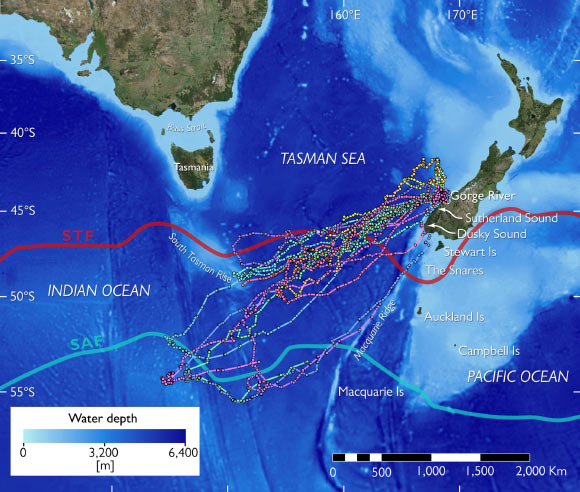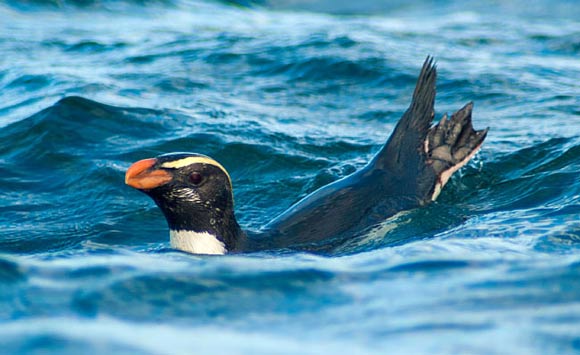The Fiordland penguin (Eudyptes pachyrhynchus), the only crested penguin species breeding on the New Zealand mainland, is currently one of the least studied and rarest penguin species in the world. In a new study of this elusive species, an international research team led by the University of Otago tracked several individuals during their post-breeding journeys and found the birds cover distances of up to 4,350 miles (7,000 km) in just eight weeks.
The Fiordland penguin, also known as tawaki, is a medium-sized, yellow-crested, black-and-white penguin.
This species grows to approximately 24 inches (60 cm) long and weighs 2 to 6 kg. It has dark, bluish-gray upperparts with a darker head, and white underparts. Its broad, yellow eyebrow-stripe extends over the eye and drops down the neck.
The bird inhabits the rugged and inaccessible coastline and fjord systems of south-western New Zealand, and is known to undertake long migrations outside breeding period.
“Tawaki go on a big trip once their chicks have fledged. On this trip the penguins need to recover from the exhausting chick rearing duties and pack on weight in preparation for their annual moult,” said study lead author Dr. Thomas Mattern, from the Department of Zoology at the University of Otago.
During this so-called pre-moult journey, time is of the essence as the birds only have eight to 10 weeks before they have to make landfall again to replace their entire plumage at once.
During the moult, the penguins cannot go out to feed and have to stay on land for three weeks, so it is important for the birds to gain a lot of weight during this journey.
“One would think that the birds try to conserve as much energy on this trip as possible. But what we found is, simply put, crazy,” Dr. Mattern said.

Overview of the southern Tasman sea bathymetry and important geographic and oceanographic features: the main oceanic fronts are indicated as red (Subtropical Front, STF) and light blue lines (Subantarctic Front, SAF); traveling paths of 17 tawaki from Gorge River, South Westland, New Zealand, during their pre-moult journey of between November 2016 and March 2017 are shown as colored dots and lines; each color represents a different individual; tracks were derived from filtered satellite data before daily averaging; note that only 5 complete tracks — i.e. tracks where the birds returned to land to moult before the satellite transmitters stopped working — were recorded. Image credit: Mattern et al, doi: 10.1371/journal.pone.0198688.
The study revealed, in a relatively short period of time, the penguins traveled enormous distances towards Antarctica to reach the sub-Antarctic Front almost 1,900 miles (3,000 km) south of New Zealand and Tasmania.
After only eight weeks they returned to the breeding sites to moult, having traveled as far as 4,350 miles during their foraging.
“This is an incredible achievement for a flightless seabird,” said co-author Dr. Klemens Pütz, from the Antarctic Research Trust.
“The question is why the penguins leave on such an epic journey, at a time when the ocean productivity along their coastal breeding sites reaches its peak. There should be more than enough food for them just on their doorstep.”
The researchers believe the penguins may be following an instinct rather than an actual need to forage in sub-Antarctic waters.
“Tawaki are one of several crested penguin species. Most crested penguins breed on islands that are located close to the sub-Antarctic front, a productive oceanic region that surrounds the Antarctic continent. Tawaki, on the other hand, breed very far north from this region,” said co-author Dr. Pablo Garcia-Borboroglu, President of the Global Penguin Society.
They believe the penguins traveling such huge distances just to reach this region may reflect a remnant behavior from an ancestral crested penguin species. Moreover, it casts new light on the current distribution of the species.
“So far, we thought that tawaki used to breed all over New Zealand, and that hunting pressure in the past 500 years caused the species to retreat to the remote areas they breed in today,” Dr. Mattern said.
“However, considering that breeding further north would add another few thousand miles to the penguins’ journey, it appears that tawaki breed exactly where their migratory behavior allows them to.”
The study was published in the journal PLoS ONE.
_____
T. Mattern et al. 2018. Marathon penguins – Reasons and consequences of long-range dispersal in Fiordland penguins / Tawaki during the pre-moult period. PLoS ONE 13 (8): e0198688; doi: 10.1371/journal.pone.0198688








